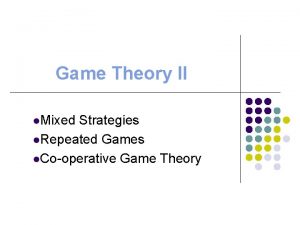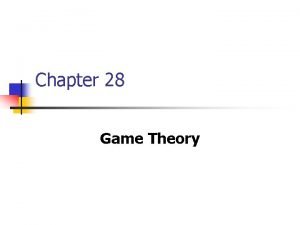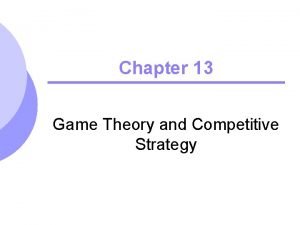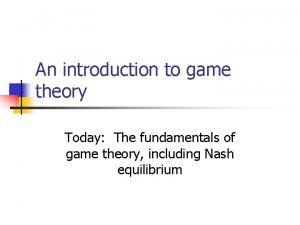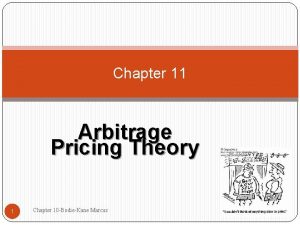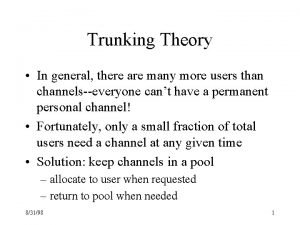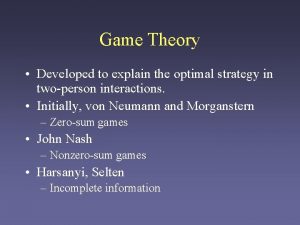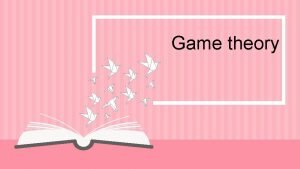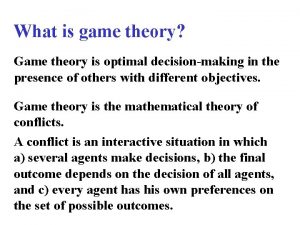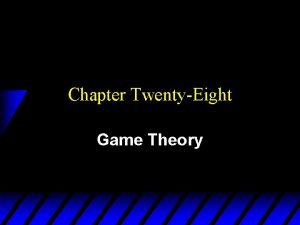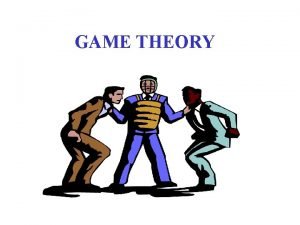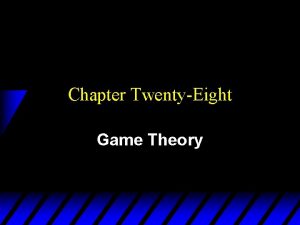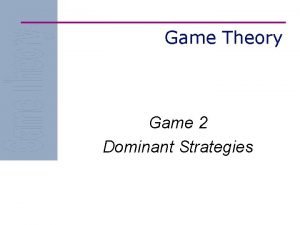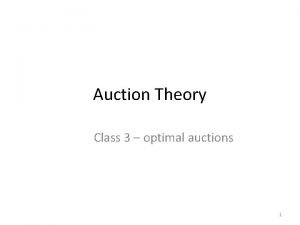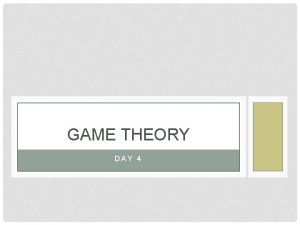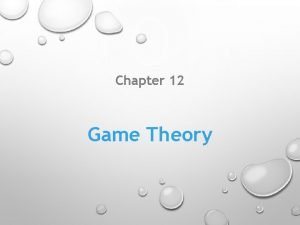Game Theory Developed to explain the optimal strategy








































- Slides: 40

Game Theory • Developed to explain the optimal strategy in two-person interactions. • Initially, von Neumann and Morganstern – Zero-sum games • John Nash – Nonzero-sum games • Harsanyi, Selten – Incomplete information

An example: Big Monkey and Little Monkey Little monkey c w Big monkey w c 0, 0 9, 1 4, 4 5, 3 What should Big Monkey do? • If BM waits, LM will climb – BM gets 9 • If BM climbs, LM will wait – BM gets 4 • BM should wait. • What about LM? • Opposite of BM (even though we’ll never get to the right side of the tree)

An example: Big Monkey and Little Monkey • These strategies (w and cw) are called best responses. – Given what the other guy is doing, this is the best thing to do. • A solution where everyone is playing a best response is called a Nash equilibrium. – No one can unilaterally change and improve things. • This representation of a game is called extensive form.

An example: Big Monkey and Little Monkey • What if the monkeys have to decide simultaneously? Little monkey c w Big monkey w 0, 0 c w c 9, 1 6 -2, 4 7 -2, 3 Now Little Monkey has to choose before he sees Big Monkey move Two Nash equilibria (c, w), (w, c) Also a third Nash equilibrium: Big Monkey chooses between c & w with probability 0. 5 (mixed strategy)

An example: Big Monkey and Little Monkey • It can often be easier to analyze a game through a different representation, called normal form Little Monkey Big Monkey c v c 5, 3 4, 4 v 9, 1 0, 0

Choosing Strategies • In the simultaneous game, it’s harder to see what each monkey should do – Mixed strategy is optimal. • Trick: How can a monkey maximize its payoff, given that it knows the other monkeys will play a Nash strategy? • Oftentimes, other techniques can be used to prune the number of possible actions.

Eliminating Dominated Strategies • The first step is to eliminate actions that are worse than another action, no matter what. Big monkey c w w Little monkey 0, 0 Little Monkey will Never choose this path. c w c 9, 1 6 -2, 4 7 -2, 3 Or this one w c 9, 1 4, 4 We can see that Big Monkey will always choose w. So the tree reduces to: 9, 1

Eliminating Dominated Strategies • We can also use this technique in normalform games: Column a b a 9, 1 4, 4 b 5, 3 0, 0 Row

Eliminating Dominated Strategies • We can also use this technique in normalform games: a b a 9, 1 4, 4 b 5, 3 0, 0 For any column action, row will prefer a.

Eliminating Dominated Strategies • We can also use this technique in normalform games: a b a 9, 1 4, 4 b 5, 3 0, 0 Given that row will pick a, column will pick b. (a, b) is the unique Nash equilibrium.

Prisoner’s Dilemma • Each player can cooperate or defect Column cooperate defect cooperate -1, -1 -10, 0 defect 0, -10 -8, -8 Row

Prisoner’s Dilemma • Each player can cooperate or defect Column cooperate defect cooperate -1, -1 -10, 0 defect 0, -10 -8, -8 Row Defecting is a dominant strategy for row

Prisoner’s Dilemma • Each player can cooperate or defect Column cooperate defect cooperate -1, -1 -10, 0 defect 0, -10 -8, -8 Row Defecting is also a dominant strategy for column

Prisoner’s Dilemma • Even though both players would be better off cooperating, mutual defection is the dominant strategy. • What drives this? – One-shot game – Inability to trust your opponent – Perfect rationality

Prisoner’s Dilemma • Relevant to: – – Arms negotiations Online Payment Product descriptions Workplace relations • How do players escape this dilemma? – Play repeatedly – Find a way to ‘guarantee’ cooperation – Change payment structure

Definition of Nash Equilibrium • A game has n players. • Each player i has a strategy set Si – This is his possible actions • Each player has a payoff function – p. I: S R • A strategy ti in Si is a best response if there is no other strategy in Si that produces a higher payoff, given the opponent’s strategies.

Definition of Nash Equilibrium • A strategy profile is a list (s 1, s 2, …, sn) of the strategies each player is using. • If each strategy is a best response given the other strategies in the profile, the profile is a Nash equilibrium. • Why is this important? – If we assume players are rational, they will play Nash strategies. – Even less-than-rational play will often converge to Nash in repeated settings.

An Example of a Nash Equilibrium Column a b a 1, 2 0, 1 b 2, 1 1, 0 Row (b, a) is a Nash equilibrium. To prove this: Given that column is playing a, row’s best response is b. Given that row is playing b, column’s best response is a.

Finding Nash Equilibria – Dominated Strategies • What to do when it’s not obvious what the equilibrium is? • In some cases, we can eliminate dominated strategies. – These are strategies that are inferior for every opponent action. • In the previous example, row = a is dominated.

Example • A 3 x 3 example: Column a b 57, 42 c a 73, 25 66, 32 b 80, 26 35, 12 32, 54 c 28, 27 63, 31 54, 29 Row

Example • A 3 x 3 example: a Column b 57, 42 c a 73, 25 66, 32 b 80, 26 35, 12 32, 54 c 28, 27 63, 31 54, 29 Row c dominates a for the column player

Example • A 3 x 3 example: a Column b 57, 42 c a 73, 25 66, 32 b 80, 26 35, 12 32, 54 c 28, 27 63, 31 54, 29 Row b is then dominated by both a and c for the row player.

Example • A 3 x 3 example: a Column b 57, 42 c a 73, 25 66, 32 b 80, 26 35, 12 32, 54 c 28, 27 63, 31 54, 29 Row Given this, b dominates c for the column player – the column player will always play b.

Example • A 3 x 3 example: a Column b 57, 42 c a 73, 25 66, 32 b 80, 26 35, 12 32, 54 c 28, 27 63, 31 54, 29 Row Since column is playing b, row will prefer c.

Example Column a b 57, 42 c a 73, 25 66, 32 b 80, 26 35, 12 32, 54 c 28, 27 63, 31 54, 29 Row We verify that (c, b) is a Nash Equilibrium by observation: If row plays c, b is the best response for column. If column plays b, c is the best response by row.

Example #2 • You try this one: Column a b c a 2, 2 1, 1 4, 0 b 1, 2 4, 1 3, 5 Row

Coordination Games • Consider the following problem: – A supplier and a buyer need to decide whether to adopt a new purchasing system. Buyer new old new 20, 20 0, 0 old 0, 0 5, 5 Supplier No dominated strategies!

Coordination Games Supplier Buyer new old new 20, 20 0, 0 old 0, 0 5, 5 • This game has two Nash equilibria (new, new) and (old, old) • Real-life examples: Beta vs VHS, Mac vs Windows vs Linux, others? • Each player wants to do what the other does • which may be different than what they say they’ll do • How to choose a strategy? Nothing is dominated.

Solving Coordination Games • Coordination games turn out to be an important real-life problem – Technology/policy/strategy adoption, delegation of authority, synchronization • Human agents tend to use “focal points” – Solutions that seem to make “natural sense” • e. g. pick a number between 1 and 10 • Social norms/rules are also used – Driving on the right/left side of the road • These strategies change the structure of the game

Price-matching Example • Two sellers are offering the same book for sale. • This book costs each seller $25. • The lowest price gets all the customers; if they match, profits are split. • What is the Nash Equilibrium strategy?

Mixed strategies • Unfortunately, not every game has a pure strategy equilibrium. – Rock-paper-scissors • However, every game has a mixed strategy Nash equilibrium. • Each action is assigned a probability of play. • Player is indifferent between actions, given these probabilities.

Mixed Strategies • In many games (such as coordination games) a player might not have a pure strategy. • Instead, optimizing payoff might require a randomized strategy (also called a mixed strategy) Wife football shopping football 2, 1 0, 0 shopping 0, 0 1, 2 Husband

Strategy Selection Wife football Husband shopping football 2, 1 0, 0 shopping 0, 0 1, 2 If we limit to pure strategies: Husband: U(football) = 0. 5 * 2 + 0. 5 * 0 = 1 U(shopping) = 0. 5 * 0 + 0. 5 * 1 = ½ Wife: U(shopping) = 1, U(football) = ½ Problem: this won’t lead to coordination!

Mixed strategy • Instead, each player selects a probability associated with each action – Goal: utility of each action is equal – Players are indifferent to choices at this probability • a=probability husband chooses football • b=probability wife chooses shopping • Since payoffs must be equal, for husband: – b*1=(1 -b)*2 b=2/3 • For wife: – a*1=(1 -a)*2 = 2/3 • In each case, expected payoff is 2/3 – 2/9 of time go to football, 2/9 shopping, 5/9 miscoordinate • If they could synchronize ahead of time they could do better.

Example: Rock paper scissors Column rock paper scissors rock 0, 0 -1, 1 1, -1 paper 1, -1 0, 0 -1, 1 scissors -1, 1 1, -1 0, 0 Row

Setup • Player 1 plays rock with probability pr, scissors with probability ps, paper with probability 1 -pr –ps • P 2: Utility(rock) = 0*pr + 1*ps – 1(1 -pr –ps) = 2 ps + pr -1 • P 2: Utility(scissors) = 0*ps + 1*(1 – pr – ps) – 1 pr = 1 – 2 pr –ps • P 2: Utility(paper) = 0*(1 -pr –ps)+ 1*pr – 1 ps = pr –ps Player 2 wants to choose a probability for each strategy so that the expected payoff for each strategy is the same.

Repeated games • Many games get played repeatedly • A common strategy for the husband-wife problem is to alternate – This leads to a payoff of 1, 2, … – 1. 5 per week. • Requires initial synchronization, plus trust that partner will go along. • Difference in formulation: we are now thinking of the game as a repeated set of interactions, rather than as a one-shot exchange.

Repeated vs Stage Games • There are two types of multiple-action games: – Stage games: players take a number of actions and then receive a payoff. • Checkers, chess, bidding in an ascending auction – Repeated games: Players repeatedly play a shorter game, receiving payoffs along the way. • Poker, blackjack, rock-paper-scissors, etc

Analyzing Stage Games • Analyzing stage games requires backward induction • We start at the last action, determine what should happen there, and work backwards. – Just like a game tree with extensive form. • Strange things can happen here: – Centipede game • Players alternate – can either cooperate and get $1 from nature or defect and steal $2 from your opponent • Game ends when one player has $100 or one player defects.

Analyzing Repeated Games • Analyzing repeated games requires us to examine the expected utility of different actions. • Assumption: game is played “infinitely often” – Weird endgame effects go away. • Prisoner’s Dilemma again: – In this case, tit-for-tat outperforms defection. • Collusion can also be explained this way. – Short-term cost of undercutting is less than long-run gains from avoiding competition.
 How to find a nash equilibrium
How to find a nash equilibrium Pirate game game theory
Pirate game game theory Game lab game theory
Game lab game theory Liar game game theory
Liar game game theory Liar game game theory
Liar game game theory Hidden information games
Hidden information games Shapley value game theory
Shapley value game theory Pure strategy nash equilibrium example
Pure strategy nash equilibrium example Game theory pure strategy
Game theory pure strategy Chapter 13 game theory and competitive strategy
Chapter 13 game theory and competitive strategy Game theory dominant strategy
Game theory dominant strategy Optimum arousal theory
Optimum arousal theory Physiological needs according to maslow
Physiological needs according to maslow Optimal arousal theory
Optimal arousal theory Optimal foraging theory ppt
Optimal foraging theory ppt Optimal theory
Optimal theory Optimal theory
Optimal theory Optimal theory
Optimal theory Game theory and graph theory
Game theory and graph theory Boykin and schoenhofer
Boykin and schoenhofer Arbitrage pricing theory exercises
Arbitrage pricing theory exercises Trunking theory
Trunking theory Hát kết hợp bộ gõ cơ thể
Hát kết hợp bộ gõ cơ thể Slidetodoc
Slidetodoc Bổ thể
Bổ thể Tỉ lệ cơ thể trẻ em
Tỉ lệ cơ thể trẻ em Chó sói
Chó sói Tư thế worm breton
Tư thế worm breton Hát lên người ơi
Hát lên người ơi Các môn thể thao bắt đầu bằng tiếng nhảy
Các môn thể thao bắt đầu bằng tiếng nhảy Thế nào là hệ số cao nhất
Thế nào là hệ số cao nhất Các châu lục và đại dương trên thế giới
Các châu lục và đại dương trên thế giới Công của trọng lực
Công của trọng lực Trời xanh đây là của chúng ta thể thơ
Trời xanh đây là của chúng ta thể thơ Cách giải mật thư tọa độ
Cách giải mật thư tọa độ Phép trừ bù
Phép trừ bù độ dài liên kết
độ dài liên kết Các châu lục và đại dương trên thế giới
Các châu lục và đại dương trên thế giới Thể thơ truyền thống
Thể thơ truyền thống Quá trình desamine hóa có thể tạo ra
Quá trình desamine hóa có thể tạo ra Một số thể thơ truyền thống
Một số thể thơ truyền thống






